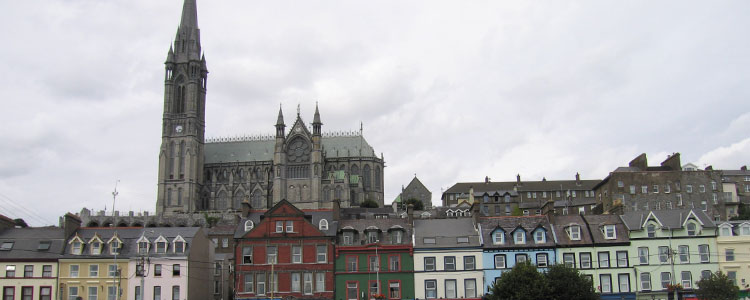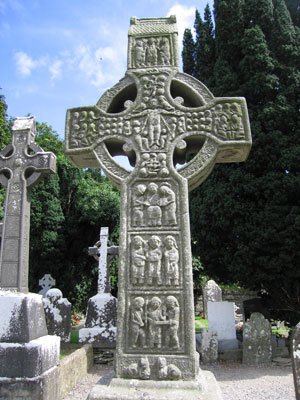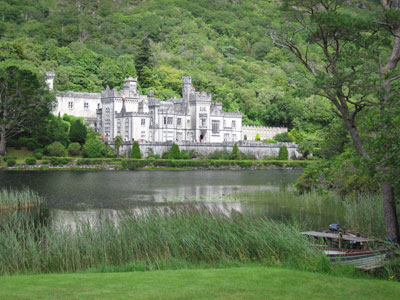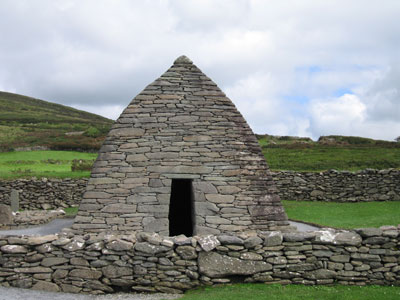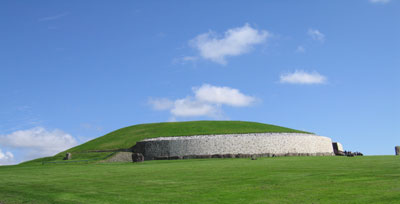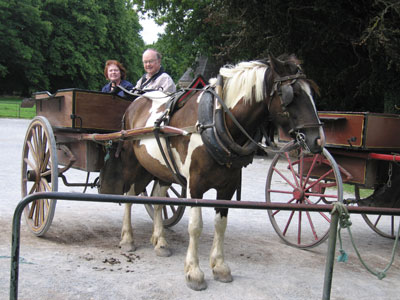Impressed with Ireland on a chauffeured tour
by Barbara McMahon; Bethesda, MD
It’s not often that a natural disaster can actually bring about a stroke of good luck, but that’s what happened to us in August 2010. My husband, Ed, and I were scheduled to travel to Ireland in late July of that year, but our 2½-week tour was canceled due to a lack of participants — a result of the spring 2010 volcanic eruption in Iceland. We had booked our own air to Ireland at a very reasonable rate and our tickets were nonrefundable. What to do?!
Readjusting
We had driven in Scotland on our own about 10 years before and found the experience hair raising, so driving in Ireland was out of the question, since we wanted a vacation, not an ordeal.
On the Internet I investigated several chauffeur companies. Some did not return my e-mails or phone calls, while others offered tours that were more expensive than we wanted. Then I found Ireland Chauffeur Travel (800/329-9138), a family business located in Cashel, County Tipperary. Their website was very appealing and straightforward.
I filled out their online form, including how many would be in our party, what, in general, we wanted to do and see, how many days we wanted to travel and what type of accommodations we would like. A few days later, Orla Leahy Kelly called me to discuss the details. She was very pleasant and efficient, and it seemed she was the one doing most of the company’s office work and itinerary planning.
We exchanged e-mails for about two weeks, perfecting the itinerary until we had designed the exact trip that Ed and I wanted.
Three days in Dublin
We decided to do Dublin on our own for three days before starting our journey with Ireland Chauffeur Travel. We stayed at the very well-located and comfortable Shelbourne Hotel (phone +353 1 6634500) for four nights, which we booked at a special Internet price ($1,110, including one dinner). The breakfasts, which were included in the rate, were some of best we have ever had.
Two of the days were spent sightseeing in Dublin, and one day was dedicated to a day tour to Glendalough, the sixth-century monastic ruin founded by St. Kevin in the Wicklow Mountains. This all-day tour, booked through Viator (866/648-5873), cost $63 for the two of us, plus lunch.
One night we went to the Merry Ploughboys traditional music show and dinner, which was excellent. The food was good enough, but the entertainment was outstanding! For a small fee, you can be picked up at your hotel and transported to their pub (phone +353 [0] 1 4930531), about an hour outside of Dublin. For both of us, the evening came to $142.
I also highly recommend the Trinity College and Book of Kells tour given by the students there. We had a very entertaining young man as our guide. There is no need to book ahead; you can make same-day tour arrangements at the entrance to the college. The price is about $13 per person, and we thought it was well worth it.
The Book of Kells exhibit is very well done. It’s true that you get to see only two pages of the actual book, but there is a large room adjacent to the Book of Kells which contains exhibits on the symbols and other facets of the book.
During our time in Dublin, we had several pub meals for lunch and dinner which were surprisingly good and inexpensive. At Café Mao, an Asian-fusion chain restaurant, dinner came to $70 for two courses each.
Dublin, for the most part, is a very walkable city, and we saw almost everything we wanted to see very easily. Along with the stop at Trinity College, we recommend a visit to the Chester Beatty Library and Dublin Castle. Christ Church, especially the interior, is also worthwhile.
Our private guide
Then it was time to be picked up by our Ireland Chauffeur Travel driver for the start of our guided adventure. Kevin Murphy arrived at the Shelbourne on time and ready to go. Semiretired, he is a very pleasant man who drives for the company on a part-time basis.
We headed off to Kilkenny, arriving in the early afternoon. Kevin purchased OPW Heritage Cards for us (included in our tour cost), which saved us a bundle of money over the next 11 days.
We liked the way Ireland Chauffeur Travel operated. Our tour cost ($8,540 for two) included all our accommodations and daily full breakfast, the driver and his expenses and all the car expenses. The cost is dependent on the level of accommodations chosen and the amount of driving involved. Not included were lunches and dinners and most of the admission charges that were not covered by the Heritage Card.
We did not have lunch or dinner with our driver; lunch was a break for him as well as for us, and by dinnertime the touring day was over. We liked this arrangement, but I think you can probably make whatever arrangements you want with the company.
Ed and I are heavy into sightseeing. I do much research prior to our trips so I know ahead of time what we want to see and where each attraction is located. On this trip, Kevin got us where we wanted to be, but he did not serve as our guide once we got there, though he did point out sights on the way to each destination. He had many interesting stories about Ireland that entertained us along the way.
In Kilkenny we saw Kilkenny Castle, the Black Abbey, St. Canice’s Cathedral and a number of other sites around this very colorful town. We had dinner ($40 for two) at Kyteler’s Inn, sections of which are 650 years old.
Our accommodation that night was well located in the middle of town, but it was our least favorite of the trip.
Cahir to Cobh
The next morning we were off to Jerpoint Abbey and Kells Priory (nothing to do with the Book of Kells). Both are interesting sites, but we found Jerpoint Abbey, with its unusual cloister figures, particularly worthwhile. Then we went on to Cahir Castle.
Certainly, we saw only a fraction of the many castles in Ireland, but Cahir Castle has to be one of the best. It is very well restored, which gives the visitor a sense of what it actually looked like in its medieval heyday. We immensely enjoyed it.
Grass does not grow under our feet when we travel, and we had the Rock of Cashel to see before nightfall. This is probably one of the most impressive sights in Ireland and it was high on our priority list. Unfortunately, certain areas were covered by extensive scaffolding, set up to protect them from water damage.
The Rock of Cashel has been approved as a UNESCO World Heritage Site, but the buildings need to be stabilized and the scaffolding removed before it can officially be added to the list. Nonetheless, it is a wonderful sight to see up on its hill.
It was a short walk down the hill to our accommodation at the Cashel Palace Hotel, a bishop’s residence in the 18th century. It is a beautiful property but needs some upkeep.
We had dinner in its pub restaurant for about $80, with wine. The food was very good.
On our agenda the next day was East Cork, Midleton, Cobh and, finally, Cork. Over the Knockmealdown Mountains and the Vee Gap we went.
The drive south was very scenic, especially the sight of Lismore Castle on the Blackwater River.
Our first stop was the Old Midleton Distillery/Jameson Heritage Center. The tour of the distillery was very well done, and the whiskey tasting afterward involved a comparison of whiskeys distilled by different methods. Ed and I also had a delicious lunch of seafood stew and soft drinks at the distillery restaurant for about $27.
Kevin met us after lunch and we were off to Cobh. The town struck me as somewhat dramatic, with St. Colman’s Cathedral dominating the skyline and, below the cathedral, colorful buildings on the main street which runs along a very picturesque waterfront.
A visit to the Queenstown Story was our objective at Cobh. A heritage center, it is located in a restored, Victorian-era railroad station and dedicated to telling the story of Irish emigration to the United States and Australia, especially during the potato famines in the mid 19th century.
Ed and I do not know the details of where our ancestors were from in Ireland; however, five of my great-grandparents and six of Ed’s were born in Ireland. All of our Irish ancestors came to the United States between 1830 and 1855, none before and none after. They all were poor and, at that time, hungry, and many came alone as indentured servants.
It was quite moving for us to look at Cobh’s harbor, an important port of emigration, and think that that was the last sight of Ireland that they had experienced.
Around Cork
We arrived late in the afternoon at Hayfield Manor in Cork, where we stayed the night. It was the only five-star hotel we stayed in on this trip, and we thoroughly enjoyed the beautiful building and grounds. We had a very delicious two-course dinner with wine in their casual restaurant for $75.
Nearby Blarney Castle is a “must see.” It is an impressive, 15th-century tower castle which can be ascended on foot. We did walk to the top, where we were rewarded with very pretty views of the countryside. We felt that the fact that two senior citizens could walk to the top was as good as kissing the Blarney Stone, which we skipped.
The Blarney Woolen Mills, with their extensive inventory, is located near the castle; it is a very good place to buy Irish goods.
We continued driving south to Kinsale, a pretty boating center on the ocean. Close to town is Charles Fort, built by the British in the late 17th century. It commands a beautiful view of Kinsale and the surrounding countryside.
After we toured Charles Fort, Kevin took us into town, where we checked into the Blue Haven Hotel. The hotel is on one of the main streets, which our room overlooked, but it was surprisingly quiet once we closed the windows at night.
Taking the scenic route
The next morning we had a new driver, Kevin Leahy. He actually founded Ireland Chauffeur Travel but now leaves much of the running of the company to his son and daughter. He told us he enjoys driving and interacting with the guests. Ed and I both found him to be a highlight of the trip.
Kevin L. knew everything about Ireland — the history, the politics, the commercial ups and downs — and we had a fascinating week with him as our driver. Also, with every destination, he knew all the roads to take for the most beautiful scenery, enhancing the itinerary so much.
The only thing set in stone on our trip was the hotel we would stay in each night. We could deviate some from the itinerary as long as we reached that night’s hotel by 5 or 6 in the evening. In some cases, I had been too ambitious in my planning, so we had to subtract a few things from the itinerary. In other cases, Kevin suggested some deviations that were much better than our original plan.
The plan on this day was to drive to Killarney by way of the Beara Peninsula. First, Kevin took us to Mizen Head, Ireland’s most southwestern point. We had a beautiful day, but the trip was a little disappointing, since we could not get out to the lighthouse because it was being renovated and was closed off.
On to the Beara Peninsula, which was beautiful beyond description! We did not go to the very tip of the peninsula but traveled over a breathtakingly gorgeous road in the middle. It was hard to imagine how anyone could have coaxed a living out of the desolate, rocky ground. However, we did see many sheep. The scenery was more lush, but just as beautiful, between the Beara Peninsula and Killarney.
Killarney
We stayed two nights in Killarney at the Killarney Royal Hotel, a very comfortable four-star property near the center of town.
On our full day there, Kevin drove us out to the Ring of Kerry, where we drove clockwise about two-thirds of the way around before heading back through the inland routes. The Ring of Kerry had the most beautiful scenery — one wonderful view after another. I especially enjoyed seeing the Skellig Islands, located about 10 miles offshore.
We arrived late in the day at Muckross House, a beautiful 19th-century house located in Killarney National Park. We passed up the house tour, spending some time in the beautiful garden before taking a jaunting cart ride to Muckross Abbey. The abbey was very photogenic and surprisingly well preserved. Very few people were there, so it was possible to get some dramatic photographs of the medieval ruins.
We went back to Killarney for dinner at the hotel restaurant, where we had a delicious meal with wine for $107.
The next morning we were off to the Dingle Peninsula by way of Ross Castle, which is situated on Lough Leane, one of the Lakes of Killarney. Within the castle is an informative museum with a three-dimensional display of a tower castle with cutouts in the exterior walls allowing views into different rooms.
Kevin believes in variety, and he even had us walk on the beach for a while near Killorglin, which was very invigorating. Daytime temperatures in Ireland were between 60° and 65°F when we were there — a far cry from the 85- to 95-degree weather we experience in Maryland in August.
Dingle Peninsula
On the Dingle Peninsula, we again experienced breathtaking scenery. We traveled around the peninsula to the Blasket Island Center, a very modern building housing an exhibit on the isolated people who lived in the Blasket Islands just off the coast. Many of them had written about their lives, and the excerpts from their stories on display in the museum were extremely interesting.
On these peninsulas, from time to time, we saw ancient Celtic ruins such as the Drombeg stone circle, beehive huts, dolmens (unique burial portals) and inscription stones, the forerunner of the Celtic cross. On the Dingle Peninsula we visited Riasc, an excavated sixth-century monastic settlement.
Riasc is hard to locate but rewarding, as it is not common to find such old ruins in Ireland. The settlement is not too far from the Gallarus Oratory, which dates from the sixth to ninth centuries and is a perfect example of early Christian architecture.
Kevin also took us to Kilmalkedar, a small, 12th-century Romanesque church which is now in ruins. The graveyard contains some fascinating ancient Celtic crosses, which were not at all like the high crosses that we were used to seeing.
It was getting late, so we went on to Dingle Town, where we stayed the night at the Benners Hotel, a cute, three-star hotel in the middle of town that we liked very much. It was very easy to find dinner; Ashes Bar had delicious pub food ($58 for two).
On all the peninsulas we visited in southwest Ireland, we had unusually bright and sunny weather. We were so blessed, because this area with its maritime climate can be very rainy. Our good weather continued to the end of the trip — not always sunny but rarely rainy.
Bunratty
Kevin had plans for us the next day as we traveled over the Slieve Mish Mountains to Tralee. He highly recommended a visit to the Kerry County Museum, which he said is the best museum in the country. He was right. It contains a fascinating exhibit of the history of the area, complete with replicas of a medieval town and a monastery.
We allotted an hour for our visit but wished we’d had at least two. We had to give up a visit to Adare in order to see the museum, but we think we made the right choice.
We wanted to get to Bunratty Folk Park and Bunratty Castle by early afternoon to have enough time to enjoy it thoroughly. Bunratty Folk Park is a village made up of buildings that have been relocated from different parts of Ireland to give visitors a sense of life in a small, 19th-century town.
This delightful village takes three to four hours to see, and there is a great deal of walking involved, since some of the buildings are spread out over a wide area. The castle is intact and extremely interesting.
In the evening, we attended a medieval banquet and show in the castle (included in our tour price). These things can be extremely touristy and not worthwhile, but this one was very well done. We enjoyed every minute of it. Afterward we had a drink at Durty Nelly’s Pub, a “must do” for travelers.
Our accommodations that night were at Bunratty Manor Hotel, located just steps from the folk park. Our room was huge, very comfortable and quiet.
Around Galway Bay
The Burren and the Cliffs of Moher were on the agenda the next day. Our first stop in the morning was the Dysert O’Dea Castle, which seemed to be in the middle of nowhere in County Clare. Another tower castle, built in the 15th century, this was my favorite. Part of a larger archaeological project, it was very simple, but its period-furnished rooms offered a realistic depiction of medieval life.
We walked to St. Tola’s Church, part of a medieval monastery. The walk took us through a cow pasture where St. Tola’s High Cross, one of the most unusual in Ireland, is located. I found this whole experience, in its simplicity, to be one of the most enjoyable of the trip.
Next, we drove through the Burren, an interesting, desolate rocky area south of Galway Bay, arriving in the afternoon at the Cliffs of Moher. Afternoon is the right time to see them, with the sun shining on the cliffs from the west.
Kevin suggested an hour’s boat ride to see them from the sea. Even though it was very clear that day, the wind was blowing hard and the sea was very rough. The boat operators warned everyone, but we all persisted in boarding. We were lucky in that Ed and I were among the half who were not seasick.
The cliffs are more dramatic from the sea than from land, and the boat trip, though very bouncy, was worthwhile.
Our accommodations for the evening, Gregans Castle Hotel, was one of two four-star castle hotels in which we stayed. A large manor house with beautiful grounds, this elegant hotel has a view of Galway Bay. Its location is very isolated, so we decided to eat in its expensive gourmet restaurant. Our dinner, though very good, cost $146 with wine.
Coast to countryside
Connemara National Park, in County Galway, was our next destination. The park’s scenery was ruggedly beautiful.
Kevin treated us to a drive on Sky Road near the town of Clifden, on the Atlantic coast. The scenery was fascinating in its desolate, austere beauty. The drive took us along a cliff overlooking the sea and the many small islands near the coast. It was truly appreciated by Ed and me.
In the evening we arrived at the Ballynahinch Castle Hotel, which seemed to be populated mostly by Americans. We had a lovely room overlooking a pretty fishing stream. Everyone there seemed to be spending their time fishing or playing golf. Since we do neither, we just spent one night there.
We had dinner in the hotel’s pub restaurant; it was noisy and we felt the food was not worth the cost ($85). The only other choice was a very expensive multicourse dinner in their fancy restaurant.
We spent the next day in medieval Ireland, seeing Clonmacnoise, an important monastic center of learning founded by St. Ciaran in 545. There are many beautiful high crosses there dating from about 900. The originals have been moved inside the on-site museum to preserve them; replicas replaced the originals around the monastery. The monastery is quite large and it took some time to see it.
We found an inexpensive tearoom at Clonmacnoise that was just perfect for a light lunch before we continued on to Tara, a place that seems to be on many Americans’ “must see” lists, even though there is not much there. Situated on a very high, commanding hill, it was the seat of the ancient High Kings of Ireland.
We also visited Trim Castle, a very large, Norman-style castle built in the late 12th century. You may wonder, at this point, if we had gotten to the boredom point with all the castles and monastic ruins we had been seeing. The answer is an emphatic ‘No!’ Each castle was different, and Trim was unlike anything we had seen in Ireland. It sits on the River Boyne, and the surrounding countryside featured very green, rolling hills.
That night we stayed in Drogheda at The D Hotel. It would have been very comfortable were it not for the poor lighting in the room, which made it seem like a cave. The hotel was adjacent to a shopping mall, where we grabbed some fast food for dinner.
Winding down
We had come to the last day of our journey. The morning was reserved for a visit to Newgrange, a very important ancient burial mound dating from about 3200 BC. The whole experience of seeing this site is well organized, with access controlled through a bus system and restrictions on the number of visitors allowed at any one time. It is a must-see experience if you are in this area of Ireland.
Our next stop was Mellifont Abbey, the first Cistercian monastery in Ireland. It was built between the 12th and 14th centuries and substantial ruins remain. There is a very interesting on-site museum that houses some of the stonework from the monastery.
Our last stop was Monasterboice. This, too, was a small, early monastic settlement which featured some spectacular high crosses. (It is home to Muiredach’s High Cross, which stands nearly 20 feet high.) It is very much off the beaten path, and no one else was there during our visit, which added to the sense of peace that permeated this place.
It was time for Kevin to drop us at the Crowne Plaza at the Dublin Airport. We had enjoyed every minute of the time we spent with him. Since we did not have time to see the northern part of the Republic of Ireland or Northern Ireland, we hope to return someday and have Kevin show us those areas.
We felt very fortunate that the Icelandic volcano caused the cancellation of our previously scheduled tour. Even though it looked like a good tour, we never would have seen as much nor seen exactly what we wanted to as we did with Ireland Chauffeur Travel. Though this was the most expensive trip we have ever taken, either on our own or on a tour, it was the most perfect.

